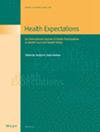Reflections on an Evidence Review Process to Inform the Co-Design of a Toolkit for Supporting End-of-Life Care Planning With People With Intellectual Disabilities
Abstract
Introduction
There is growing recognition that healthcare inequalities faced by people with intellectual disabilities extend to their experiences at the end of life, resulting in calls for more inclusive research to help address these inequities. Our study aimed to address this through the co-design of a toolkit for supporting end-of-life care planning with people with intellectual disabilities. To inform the co-design process, we undertook an evidence review to identify existing tools, resources and approaches that were already being used in practice.
Methods
Our evidence review comprised three components: (i) a rapid scoping review of the academic literature, (ii) a desk-based search of the grey literature and (iii) an online survey to capture unpublished resources that were distributed to services, professionals, third-sector organisations and family members. A longlist of existing materials was appraised using an adapted version of the AGREE II instrument, resulting in a shortlist that was shared with the co-design team.
Results
The evidence review played a critical role in the co-design of a new toolkit of end-of-life care resources for people with intellectual disabilities. However, AGREE II proved to be limited for our purposes.
Conclusions
The survey was particularly useful in helping us identify resources, tools and approaches in current use. We identified evidence review processes that served to support co-design team activities and elements that were more problematic. We argue that evidence review practices might be enhanced to better aid co-design activities in health and care research, particularly for studies involving people with intellectual disabilities.
Patient or Public Contribution
This article reflects on an evidence review that was conducted as part of The Victoria and Stuart Project. People with intellectual disabilities were deeply involved at every stage of project design, delivery and dissemination. The project employed people with intellectual disabilities as members of the core research team. People with intellectual disabilities and family carers were members of the project co-design team and the project Advisory Group. The evidence review process itself was led by academic members of the research team with contributions from colleagues with intellectual disabilities via the Advisory Group and core research team. The findings from the evidence review were used by the co-design team to inform the development of an end-of-life care planning toolkit for people with intellectual disabilities.


 求助内容:
求助内容: 应助结果提醒方式:
应助结果提醒方式:


